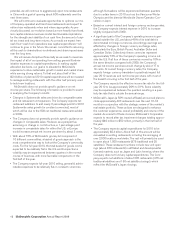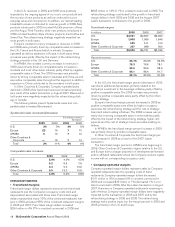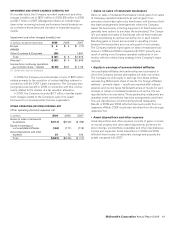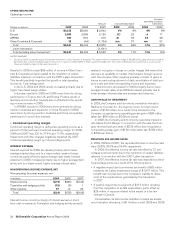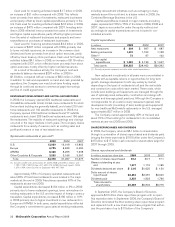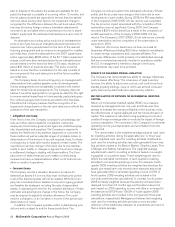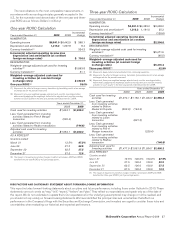McDonalds 2009 Annual Report Download - page 23
Download and view the complete annual report
Please find page 23 of the 2009 McDonalds annual report below. You can navigate through the pages in the report by either clicking on the pages listed below, or by using the keyword search tool below to find specific information within the annual report.
Substantially all of the net tax assets arose in the U.S. and other
profitable markets.
DISCONTINUED OPERATIONS
Over the last several years, the Company has continued to focus
its management and financial resources on the McDonald’s res-
taurant business as it believes the opportunities for long-term
growth remain significant. Accordingly, during third quarter 2007,
the Company sold its investment in Boston Market. As a result of
the disposal, Boston Market’s results of operations and trans-
action gain are reflected as discontinued operations. In
connection with the sale, the Company received proceeds of
approximately $250 million and recorded a gain of $69 million
after tax. In addition, Boston Market’s net loss for 2007 was
$9 million.
ACCOUNTING CHANGES
• Sabbatical leave
In 2006, the Financial Accounting Standards Board (FASB)
issued guidance on accounting for sabbatical leave, codified in
the Compensation – General Topic of the FASB Accounting
Standards Codification (ASC). Under this guidance, compensa-
tion costs associated with a sabbatical should be accrued over
the requisite service period, assuming certain conditions are met.
The Company adopted the guidance effective January 1, 2007,
as required and accordingly, recorded a $36 million cumulative
adjustment, net of tax, to decrease the January 1, 2007 balance
of retained earnings. The annual impact to earnings is not sig-
nificant.
• Income tax uncertainties
In 2006, the FASB issued guidance on accounting for
uncertainty in income taxes, codified primarily in the Income
Taxes Topic of the FASB ASC. This guidance clarifies the
accounting for income taxes by prescribing the minimum recog-
nition threshold a tax position is required to meet before being
recognized in the financial statements. The guidance also covers
derecognition, measurement, classification, interest and penalties,
accounting in interim periods, disclosure and transition. The
Company adopted the guidance effective January 1, 2007, as
required. As a result of the implementation, the Company
recorded a $20 million cumulative adjustment to increase the
January 1, 2007 balance of retained earnings. The guidance
requires that a liability associated with an unrecognized tax bene-
fit be classified as a long-term liability except for the amount for
which cash payment is anticipated within one year. Upon adop-
tion of the guidance, $339 million of tax liabilities, net of
deposits, were reclassified from current to long-term and
included in other long-term liabilities.
• Fair value measurements
In 2006, the FASB issued guidance on fair value measurements,
codified primarily in the Fair Value Measurements and Dis-
closures Topic of the FASB ASC. This guidance defines fair
value, establishes a framework for measuring fair value in
accordance with generally accepted accounting principles, and
expands disclosures about fair value measurements. This guid-
ance does not require any new fair value measurements; rather, it
applies to other accounting pronouncements that require or
permit fair value measurements. The provisions of the guidance,
as issued, were effective January 1, 2008. However, in February
2008, the FASB deferred the effective date for one year for cer-
tain non-financial assets and non-financial liabilities, except those
that are recognized or disclosed at fair value in the financial
statements on a recurring basis (i.e., at least annually). The
Company adopted the required provisions related to debt and
derivatives as of January 1, 2008 and adopted the remaining
required provisions for non-financial assets and liabilities as of
January 1, 2009. The effect of adoption was not significant in
either period.
• Subsequent events
In May 2009, the FASB issued guidance on subsequent events,
codified in the Subsequent Events Topic of the FASB ASC. This
guidance sets forth the period after the balance sheet date dur-
ing which management of a reporting entity should evaluate
events or transactions that may occur for potential recognition or
disclosure in the financial statements. The guidance also
indicates the circumstances under which an entity should recog-
nize events or transactions occurring after the balance sheet date
in its financial statements, as well as the disclosures that an
entity should make about events or transactions that occurred
after the balance sheet date. The Company adopted this guid-
ance beginning in the second quarter 2009. The adoption had no
impact on our consolidated financial statements, besides the
additional disclosure.
• Variable interest entities and consolidation
In June 2009, the FASB issued amendments to the guidance on
variable interest entities and consolidation, codified primarily in
the Consolidation Topic of the FASB ASC. This guidance modi-
fies the method for determining whether an entity is a variable
interest entity as well as the methods permitted for determining
the primary beneficiary of a variable interest entity. In addition,
this guidance requires ongoing reassessments of whether a
company is the primary beneficiary of a variable interest entity
and enhanced disclosures related to a company’s involvement
with a variable interest entity. This guidance was effective begin-
ning January 1, 2010, and we do not expect the adoption to have
a significant impact on our consolidated financial statements.
Cash Flows
The Company generates significant cash from its operations and
has substantial credit availability and capacity to fund operating
and discretionary spending such as capital expenditures, debt
repayments, dividends and share repurchases.
Cash provided by operations totaled $5.8 billion and
$5.9 billion in 2009 and 2008, respectively, and exceeded capi-
tal expenditures by $3.8 billion in both years. In 2009, cash
provided by operations decreased $166 million or 3% compared
with 2008 despite increased operating results, primarily due to
higher income tax payments, higher noncash income items and
the receipt of $143 million in 2008 related to the completion of
an IRS examination. In 2008, cash provided by operations
increased $1.0 billion or 21% compared with 2007 primarily due
to increased operating results and changes in working capital,
partly due to lower income tax payments and the receipt of $143
million related to the IRS examination.
McDonald’s Corporation Annual Report 2009 21



